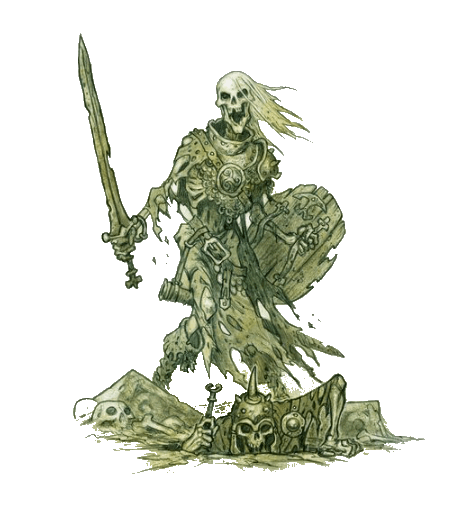


Anytime ten or more skeletons are found together and fought together, when four or more have been defeated in a way that doesn't entirely vaporous their substance — as when a cleric destroys undead — there is a 25% chance those four will form into reborn one, a 4+3 HD specimen with 27 HP with the same treasure as other skeletons.
Once per encounter, a cleric may target any undead within thirty feet of her position by showing her holy symbol and calling down the wrath of whatever power the cleric serves. Roll one d8 die per total core class Cleric levels the cleric possesses — or one d8 die per (overall character levels divided by two, and rounded down) — whichever is greater. Treat these like Fray Dice that can only target these particular undead.
In the context of Scarlet Horizons, a turning attempt occurs when a non-evil cleric presents her holy symbol and pronounces anathema on undead within thirty feet of the cleric. This turning attempt is accompanied by a d20 roll and the Turn Undead table is consulted. For each type of undead present (i.e., within thirty feet of the cleric), cross-reference the full core-Cleric class levels of the cleric with the HD of that particular undead. If there isn't a table entry, the cleric isn't yet powerful enough to affect that undead. A numerical entry in the table means if your d20 result is that high or higher, that undead will move its maximum possible distance from you over the course of the next five rounds.
A result of "T" means that particular undead is automatically turned and will stay as far from you as it can get for the duration of the encounter while you continue to display your holy symbol, given your power as a cleric; and a "D" result means the undead is utterly destroyed.
A cleric gets a single turning attempt per undead entity per encounter and must make the attempt the very first round of the encounter. In subsequent rounds, a cleric may target undead that were not (T)urned or (D)estroyed by making a Fray Die attack up to thirty feet away each round against a particular undead entity, inflicting the Fray Die result as HD of radiant damage.
Note that individual undead for which there isn't a result of (T) or (D) on the table may attack you after five rounds have elapsed, assuming your turn attempt was strong enough to make them temporarily flee in the first place.
If a cleric opts to attempt to Turn Undead in the first round of an encounter in which one or more undead are present, she may not make a normal use of Fray Die in that round. For a round in which a cleric uses her Fray Die to inflict radiant damage against a particular undead entity, the cleric may not make a normal Fray Die use against another target.